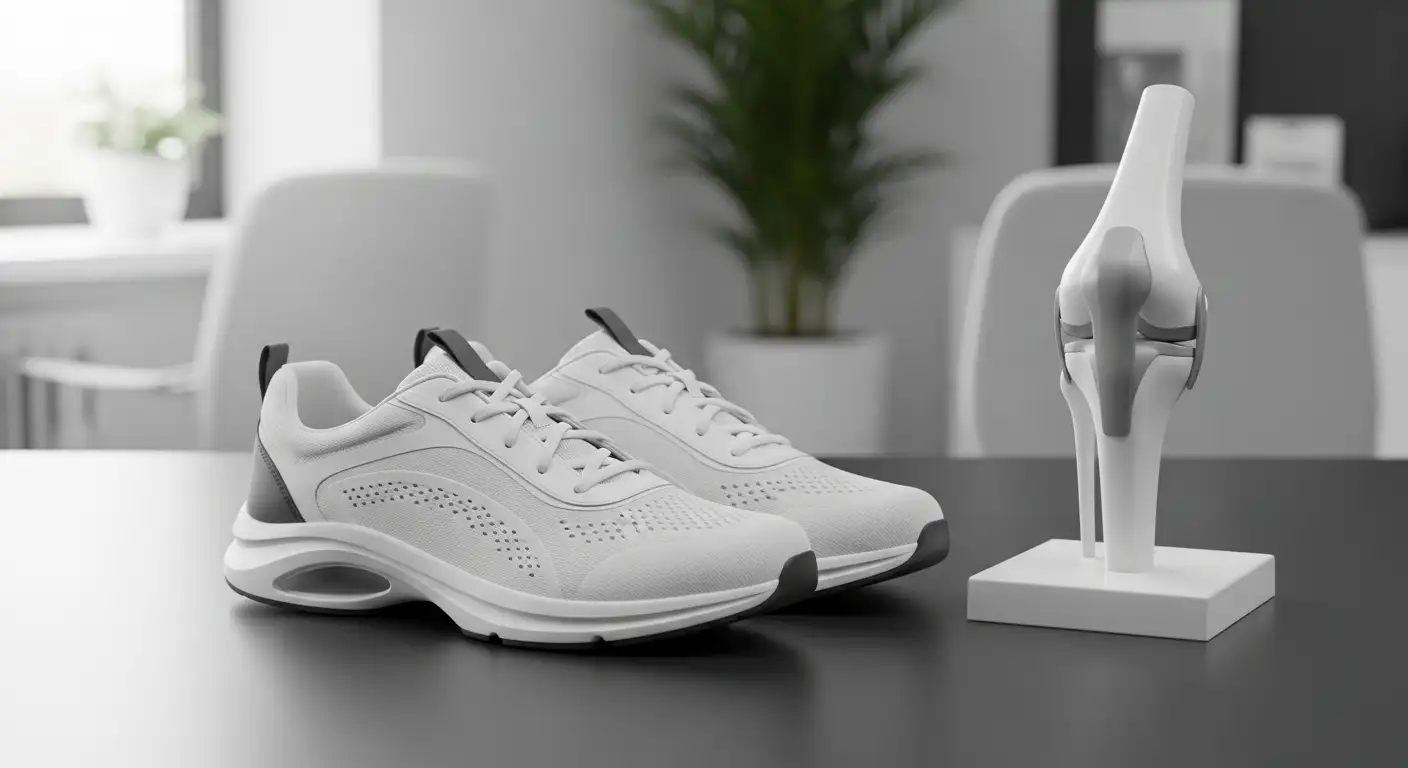Understanding Bone-on-Bone Knee Pain
Before we delve into managing bone-on-bone knee pain without surgery, it's important to first understand what this condition entails and the symptoms associated with it.
What is Bone-on-Bone Knee Pain?
Bone-on-bone knee pain is a term commonly used to describe the pain experienced when the protective cartilage in the knee joint wears away completely. This results in the bones in the knee rubbing directly against each other, leading to severe discomfort, pain, and inflammation. This condition is often a result of advanced osteoarthritis, a degenerative joint disease that progressively wears down the cartilage in the joints.

Causes and Symptoms
The main cause of bone-on-bone knee pain is the progressive wear and tear of the knee joint, often due to aging and overuse. It's also more common in individuals who are overweight or obese since the excess weight puts more pressure on the joints, accelerating the wear and tear process. According to the Arthritis Foundation, being just 10 pounds overweight can result in an additional 15 to 50 pounds of pressure on the knees, increasing the likelihood of developing or worsening osteoarthritis.
The symptoms of bone-on-bone knee pain include severe and persistent pain in the knee, stiffness, inflammation, reduced mobility, and a grating or scraping sensation when moving the knee. These symptoms often worsen after physical activities or long periods of inactivity.
Understanding the cause and symptoms of bone-on-bone knee pain is crucial in determining the best non-surgical interventions for managing the pain and improving the quality of life. Various approaches such as physical therapy, lifestyle modifications, medications, and alternative therapies can be explored to help alleviate the pain and enhance knee function.
Non-Surgical Treatments for Knee Pain
Managing bone-on-bone knee pain without surgery can be achieved through a variety of treatments. This section focuses on non-surgical methods, specifically physical therapy approaches and the use of assistive devices.
Physical Therapy Approaches
Physical therapy can be effective in managing bone-on-bone knee pain. By strengthening the muscles around the knee joint, it provides better support and improves overall function.
A typical therapy regimen targets various muscle groups, notably the quadriceps, hamstrings, and calves. Cardiovascular exercises like cycling, elliptical use, swimming, and rollerblading are also recommended. These should be performed at least three times a week, with limited bending of the knee, not exceeding 45 degrees [2].
According to a study, moderate intensity aerobic exercise for 150 minutes per week or moderate-to-vigorous physical activity muscle-strengthening exercises for 2 days per week can reduce symptoms and improve physical function in individuals with knee osteoarthritis. Quadriceps-specific exercises and supervised exercises performed at least three times per week have shown greater pain reduction. Patient-centered rehabilitation, considering patient preferences and access to exercise equipment, is crucial for improving outcomes.
Role of Assistive Devices
Assistive devices like a knee brace can help reduce pain and improve function for individuals dealing with bone-on-bone knee pain without surgical intervention [1].
Knee braces, particularly those designed for medial compartmental osteoarthritis (arthritis on the inside of the knee joint), can alleviate pain and discomfort by relieving the weight from the affected side of the knee. However, these braces need to be custom-made and can be costly.
The use of these treatments, combined with lifestyle modifications and medicinal approaches, can provide relief for bone-on-bone knee pain without the need for surgery. As always, it's important to consult with a healthcare professional to determine the best treatment plan for your individual needs.
Lifestyle Modifications for Pain Relief
Managing bone-on-bone knee pain without surgery often involves making critical lifestyle adjustments. These changes aim to reduce pressure on the knees, improve mobility, and decrease pain levels. Notably, weight management and exercise modification are two key strategies in this regard.
Importance of Weight Management
Studies indicate that overweight or obese patients with knee osteoarthritis (OA), a condition that often results in bone-on-bone knee pain, can benefit significantly from weight loss. According to the Arthritis Foundation, being just 10 pounds overweight can result in an additional 15 to 50 pounds of pressure on the knees, accelerating cartilage destruction.
Moreover, losing just 10% of body weight can reduce arthritis pain by half, with an additional 25% or more pain reduction upon losing 20% of body weight. This weight loss not only alleviates arthritis pain but can also lower blood pressure and decrease the risk of diabetes and heart disease.
Unfortunately, less than 40% of patients with knee OA receive recommended first-line treatments such as patient education, physical exercise, and weight loss. There is a need for healthcare providers to educate themselves and their patients about the current best evidence-based practices for knee OA.
Exercise and Activity Modifications
Physical activity and exercise therapy have been proven to reduce symptoms and improve physical function in individuals with knee OA. Recommended exercise regimens include moderate-intensity aerobic exercise for 150 minutes per week or moderate-to-vigorous physical activity muscle-strengthening exercises for 2 days per week. Quadriceps-specific exercises and supervised exercises performed at least three times per week have shown greater pain reduction.
Exercise protocols, however, should be individualized based on the clinical evaluation and patient preferences. Strategies to increase exercise adherence and overcome barriers, such as patient education, positive therapeutic relationships, goal setting, and follow-up sessions, can optimize the effectiveness of exercise interventions [3].
In conclusion, lifestyle modifications, particularly weight management and exercise modifications, play a crucial role in managing bone-on-bone knee pain without surgery. These changes, along with other non-surgical treatments, can help individuals with knee pain lead a healthier, more active life.
Medicinal Approaches to Pain Management
When managing bone-on-bone knee pain without surgery, medicinal approaches often serve as a first line of defense. These treatments primarily focus on alleviating pain and inflammation, helping patients maintain mobility and quality of life.
Over-the-Counter Medications
Over-the-counter medications may be recommended to alleviate symptoms of bone-on-bone knee pain. These include pain relievers such as acetaminophen and Non-Steroidal Anti-Inflammatory Drugs (NSAIDs). Corticosteroids may also be prescribed to help reduce inflammation and provide relief from pain.
While these medications can be effective in managing symptoms, they should be used under the guidance of a healthcare professional. Long-term use of certain medications can lead to potential side effects, so it's important to discuss any concerns with your doctor.
Knee Injections
Injections into the knee joint serve as another non-surgical intervention option for individuals with bone-on-bone knee pain. Two common types of injections include hyaluronic acid (HA) injections and corticosteroid injections. These injections help to provide pain relief, reduce inflammation, and improve mobility.
Hyaluronic acid is a natural substance found in healthy joint fluid, acting as a lubricant and shock absorber. Injections of HA can help reduce pain and improve knee joint function in individuals with knee osteoarthritis.
Corticosteroid injections provide anti-inflammatory effects, reducing pain and swelling in the joint. These injections can offer immediate relief for patients. However, repeated use of corticosteroid injections may have adverse effects on cartilage in the joint [4].
It's essential to remember that while these medicinal approaches can provide significant relief from bone-on-bone knee pain, they should be used as part of a comprehensive treatment plan that also includes lifestyle modifications and physical therapies. Always consult with a healthcare professional before starting any new treatment regimen.
Exploring Alternative Therapies
When considering methods of managing bone-on-bone knee pain without surgery, it is worth exploring alternative therapies. These methods, which often complement traditional treatments, can offer relief and improved functionality for those experiencing knee pain. Two such therapies are acupuncture and chiropractic care.
Acupuncture and Chiropractic Care
Acupuncture is a system of healthcare that has been practiced for over 3000 years and has gained acceptance in the United States. It is an effective treatment for pain and physical dysfunction associated with osteoarthritis of the knee. The FDA has reclassified acupuncture needles from Class III to Class II, and the National Institutes of Health recognizes its usefulness for conditions like postoperative nausea, vomiting, and osteoarthritis.
Acupuncture works to relieve pain through various mechanisms, including the gate-control mechanism and the release of neurochemicals like endorphins and monoamines. In particular, 10 trials involving 1456 participants have shown that acupuncture provides significant relief from symptoms of knee osteoarthritis.
Chiropractic care is another therapy worth considering. Chiropractors manipulate or adjust the spine to improve pain and mobility, which they believe can impact the function of all organs and systems in the body. They specialize in maximizing the function of arthritic joints to restore patients' function for a better quality of life.
Chiropractic therapy can involve gentle manipulation of soft tissue to relieve muscle spasms, active exercises, or traction to improve joint range of motion. With more than 150 techniques, it offers a versatile approach to relieving knee pain.
Regenerative Medicine Techniques
Regenerative medicine techniques are cutting-edge therapies that aim to repair and regenerate tissues in the body. These techniques, which include stem cell therapy and platelet-rich plasma injections, can potentially improve knee function and alleviate pain.
Stem cell therapy involves the injection of stem cells into the knee to stimulate the body's natural healing process. These cells can differentiate into various types of cells, including bone, cartilage, and muscle cells, promoting the repair of damaged tissues.
Platelet-rich plasma injections involve the use of a patient's own platelets to promote healing. The platelets are injected into the knee, where they release growth factors that stimulate tissue regeneration and repair.
While these techniques show promise, they are still relatively new, and further research is needed to fully understand their effectiveness and long-term effects. As with any treatment, it's important to discuss these options with a healthcare provider to determine the best course of action for managing bone-on-bone knee pain without surgery.
Precautions and Considerations
While there are non-surgical methods available for managing bone-on-bone knee pain, it's crucial to be aware of the appropriate time to seek medical help and understand the potential risks and side effects associated with different treatments.
When to Seek Medical Help
Although the focus of this article is on managing knee pain without surgery, it's important to understand that medical consultation is a key part of the process. If one's knee pain persists despite trying various non-surgical interventions, or if the pain worsens, medical help should be sought immediately.
Moreover, if there are signs of infection, such as redness, warmth, or fever, or if the knee becomes unstable or locks up, these are indications to consult a healthcare professional. It's also necessary to seek immediate medical attention if the knee pain is due to an injury or accident.
Potential Risks and Side Effects
Different non-surgical intervention methods carry various potential risks and side effects. For instance, while exercise is generally beneficial, excessive or incorrect exercises can result in further knee damage. It's always recommended to consult with a physical therapist to ensure exercises are being performed correctly.
Over-the-counter medications like aspirin, ibuprofen, and naproxen may help reduce symptoms of knee osteoarthritis. However, these should be taken with caution as they can have side effects, especially when taken over a long period of time. These can include stomach ulcers, kidney damage, and increased risk of heart problems.
Nutritional supplements like glucosamine sulfate and chondroitin sulfate are widely used for knee osteoarthritis, but they are not regulated by the FDA. Their effectiveness and potential long-term adverse effects are still being studied.
The use of knee braces can help relieve pain and discomfort, but they must be custom-made and can be costly. They may also cause discomfort and skin problems if not fitted correctly.
Viscosupplementation, a method involving the injection of substances like hyaluronic acid into the knee joint, may only provide symptom relief for about 50% of patients. These injections can also cause side effects such as pain, swelling, heat, and redness at the injection site.
Understanding these potential risks and side effects can help individuals with knee pain make informed decisions about their treatment options. It's always recommended to discuss these factors with a healthcare professional before starting any new treatment.
References
[1]: https://www.mayoclinic.org/diseases-conditions/knee-pain/diagnosis-treatment/drc-20350855
[2]: https://www.sutterhealth.org/services/orthopedic/non-surgical-treatment-knee-osteoarthritis
[3]: https://www.ncbi.nlm.nih.gov/pmc/articles/PMC7990728/
[4]: https://www.massgeneralbrigham.org/en/about/newsroom/articles/types-of-injections-that-can-help-with-joint-pain
[5]: https://www.ncbi.nlm.nih.gov/pmc/articles/PMC2810544/
[6]: https://www.arthritis.org/health-wellness/treatment/complementary-therapies/physical-therapies/chiropractic-care-for-arthritis





